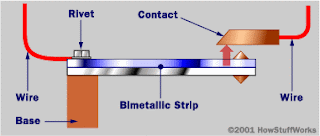The Principle
Regarding to www.howstuffworks.com, the principle behind a bimetallic strip thermometer relies on the fact that different metals expand at different rates as they warm up. By bonding two different metals together, you can make a simple electric controller that can withstand fairly high temperatures. This sort of controller is often found in ovens. It is shown in the diagram below.
Two metals make up the bimetallic strip (hence the name). In this diagram, the green metal would be chosen to expand faster than the blue metal if the device were being used in an oven. In a refrigerator, you would use the opposite setup, so that as the temperature rises the blue metal expands faster than the green metal. This causes the strip to bend upward, making contact so that current can flow. By adjusting the size of the gap between the strip and the contact, you control the temperature.
You will often find long bimetallic strips coiled into spirals. This is the typical layout of a backyard dial thermometer. By coiling a very long strip it becomes much more sensitive to small temperature changes. In a furnace thermostat, the same technique is used and a mercury switch is attached to the coil. The switch turns the furnace on and off.
How to Calibrate
There are two common ways to calibrate this kind of sensor, the ice and boiling method.
The Ice Method
Immerse the temperature probe at least two inches into a glass of finely crushed ice. Add cold tap water to remove air pockets. Wait at least 1 minute. The gauge should read 32 degrees F or 0 degree C. If it does not, turn the adjustment nut on the back of the reading dial with a pair of pliers until the dial reads 32 degrees F or 0 degree C. Wait at least 1 minute to verify correct adjustment.
The Boiling Method
Submerge the probe into boiling water. Wait until the needle stops moving, then adjust the calibration nut until the dial reads 212 degrees F or 100 degrees C. Since the boiling point of water decreases as altitude increases, this method may not be as accurate as the ice method at altitudes above sea level unless the exact boiling point temperature is known.
Advantage and Disadvantage
Advantages of bimetallic devices are its portability and independence from a power supply. It also can be directly used for automatic on-off switch based on temperature increasing. The simple sample is an automatic iron and food processing devices (e.g. microwave, oven, toaster, etc).
However, they are not usually quite as accurate as are electrical devices, and you cannot easily record the temperature value as with electrical devices like thermocouples or RTDs. It also need to be calibrated frequently to make sure of its accuracy.
Bimetallic Thermometers
Saturday, May 22, 2010
Labels:
bimetal,
calibrate,
sensors,
temperature,
thermal
Posted by
MasHadi
at
2:52 PM
2
comments
![]()
Subscribe to:
Comments (Atom)